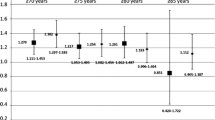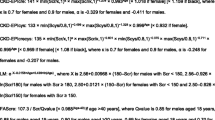Abstract
It is known that the common physiological denominator of the ageing process is an attenuation of functional performance with respect to the situation of young people and adults. However, since the first cohort-based longitudinal studies, it has not been possible to establish a “linear” relationship between age and glomerular filtration in all cases. This does not mean that there is no physiological ageing process at all; in addition to those already elucidated, its mechanisms include cell senescence, podocyte dysfunction, a vitamin D deficiency, and homozygotic forms of the MYH9 gene. The aim of the present work was to analyse the prevalence of chronic kidney disease (CKD) and, where possible, the correlation between CKD, defined by an eGFR < 60 ml/min/1.73 m2, plasma 25(OH)D3 levels and the MYH9 gene in a population of elderly and very elderly persons. These parameters have not been evaluated previously in populations of elderly and very elderly patients. It is concluded that a moderate decrease in the eGFR occurs with age. This does not imply the presence of CKD in elderly people, since in most individuals the reduced eGFR is not accompanied by anaemia, and no individuals show hypocalcaemia, hyperphosphataemia or a high Alb/Cr ratio. Here we observed a lower Hb level and an elevated Alb/Cr ratio in subjects heterozygotic for the MYH9 gene. This could be interpreted in the sense that the gene could exert some protective effect on renal function, whereas the heterozygotic form (allele A) of the MYH9 gene could be considered a very early marker, a new risk factor for the appearance of CKD, or a sign of renal frailty in elderly people.
Similar content being viewed by others
References
Eggers PW (2009) The aging pandemic: demographic changes in the general and end-stage disease population. Semin Nephol 29(6):551–554
CDC The state of Aging and Health in American (2007) Report in vol 20079 centers for disease control and prevention
Zhang QL, Rothenbacher D (2008) Prevalence of chronic kidney disease in population-based studies: systematic review. BMC Public Health 8(1):117
Lindeman RD, Tobin J, Shock NW (1985) Longitudinal studies on the rate of decline in renal function with age. J Am Geriatr Soc 33:273
Hemmelgarm BR, Zhang J, Manns BJ, Tonelli M, Larsen E, Ghall WA, Southern DA, McLaughlin K, Mortis G, Culleton BF (2006) Progression of kidney dysfunction in the community-dwelling elderly. Kidney Int 69(12):2155–2161
Muntner P (2009) Longitudinal measurements of renal function. Semin Nephrol 29(6):650–657
Hsu CY, Iribarren C, McCulloch CE, Darbinian J, Go AS (2009) Risk factors for end-stage renal disease: 25-year follow-up. Arch Int Med 169(4):342–350
Melk A, Ramassar V, Helms LMH, Moore R, Rayner D, Solez K, Halloran PF (2000) Telomere shortening in kidney with age. J Am Soc Nephrol 11:444–453
Floege J, Hackmann B, Kliem V, Kriz W, Alpers CE, Johnson RJ (1997) Age-related glomerulosclerosis and interstitial fibrosis in Milan normotensive rats: a podocyte disease. Kidney Int 51(1):230–243
Wiggins J (2009) Podocytes and glomerular function with aging. Semin Nephrol 29(6):587–593
Bostrom MA, Freedman BI (2010) The spectrum of MYH9-associted nephropathy. Clin J Am Soc Nephrol 5:1107–1113
Odera K, Goto S, Takahaski R (2007) Age-related change of endocytic receptors megalin and cubilin in the kidney in rats. Biogerentology 8:505–515
Marini M, Bruschi M, Pecci A et al (2006) Non-muscle myosin heavy chain IIA and IIB interact and co-localize in living cells: relevance for MYH9-related disease. Int J Mol Med 17:729–736
Kopp JB, Smith MW, Nelson GW et al (2008) MYH9 is a major effect risk gene for focal segmental glomerulosclerosis. Nat Genet 40:1175–1184
Freedman BI, Hicks PJ, Bostrom MA et al (2009) Polymorphisms in the non-muscle myosin heavy chain 9 gene (MYH9) are strongly associated with end-stage renal disease historically attributed to hypertension in African Americans. Kidney Int 75:736–745
Kao WH, Klag MJ, Meoni LA, Reich D, Berthier-Schaad Y et al (2008) MYH9 is associated with nondiabetic end-stage renal disease in African Americans. Nat Genet 40:1185–1192
Matsha TE, Masconi K, Yako YY et al (2012) Polymorphisms in the non-muscle myosin heavy chain gene (MYH9) are associated with lower glomerular filtration rate in mixed ancestry diabetic subjects from South Africa. PLoS One 7(12):e52529. doi:10.1371/Journal.pone.0052529
Freedman BI, Langefeld CD, Turner J et al (2012) Association of APOL 1 variants with mild kidney disease in the first-degree relatives of African American patients with non-diabetic endstage renal disease. Kidney Int 82:805–811
Franceschini N, Voruganti VS, Haack K et al (2010) The association of the MYH9 gene and kidney outcomes in American Indians: the strong heart family study. Hum Genet 127(3):295–301
Diez-Ojea B, Marin R, Coto E, Tavira B, Fernandez-Vega F, Alvarez R, Fernandez-Fresnedo G, Pobes A, Suarez-Laures A, Garcia-Monteavaro C, Gorostidi M, Sanchez E, Arias M, Ortega F (2014) Association of the MYH9 gene polymorphisms with chronic renal disease secondary to hypertensive nephrosclerosis, in a Caucasian population. Am J Int Med. 2(6):95–101
Tavira B, Coto E, Gómez J, Tranche S, Miguélez K, Ortega F, Díez B, Sánchez E, Marín R, Arenase J, Alvarez V (2013) Association between a MYH9 polymorphism (rs3752462) and renal function in the Spanish RENASTUR cohort. Gene 520(1):73–76
Yu A (2004) Renal transport of calcium, magnesium and phosphate. In: Brenner B (ed) Brenner & rector´s the kidney. Saunders, Philadelphia, pp 535–571
Musso CG, Alvarez Gregori JA, Macías Núñez JF (2008) Renal handling of uric acid, magnesium, phosphorus, calcium and acid base equilibrium in the elderly. In: Macias Nuñez JF, Cameron JS Oreopoulos DG (eds) The aging kidney in health and disease, vol 9, Springer, Secaucus, NJ. pp 155–172
Friedman PA, Gesek FA (1995) Cellular calcium transport in renal epithelia: measurements, mechanism and regulation. Physiol Rev 75:429–471
Suki WN, Rose D (1996) Renal transport of calcium, magnesium and phosphate. In: Brenner BM (ed) The Kidney, vol 1., PhiladelphiaPA, Saunders, pp 472–515
Alvarez-Gregori JA, Robles NR, Mena C, Ardanuy R, Macias-Nuñez JF (2011) The value of a formula including haematocrit, blood urea and gender (HUGE) as a screening test for chronic renal insufficiency. J Nutr Health Aging 15(6):480–484
Grimes DA, Schulz KF (2002) Uses and abuses of screening tests. Lancet 359:881–884
Poggio ED, Rule AD (2009) A critical evaluation of chronic kidney disease. Should one isolated reduced estimated glomerular filtration rate be considered a ‘disease’? Nephrol Dial Transpl 24:698–700
Giles PD, Rylance PB, Crothers DC (2008) New results from the modification of diet in renal disease study: the importance of clinical outcomes in test strategies for early chronic kidney disease. QJM 101(2):155–158
Author information
Authors and Affiliations
Corresponding author
Ethics declarations
Conflict of interest
The authors declare no conflict of interest.
Rights and permissions
About this article
Cite this article
Otero Gonzalez, A., Prol, M.P.B., Caride, M.J.C. et al. Estimated glomerular filtration rate (eGFR), 25(OH) D3, chronic kidney disease (CKD), the MYH9 (myosin heavy chain 9) gene in old and very elderly people. Int Urol Nephrol 47, 1403–1408 (2015). https://doi.org/10.1007/s11255-015-1041-x
Received:
Accepted:
Published:
Issue Date:
DOI: https://doi.org/10.1007/s11255-015-1041-x




